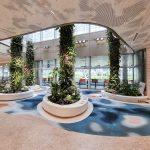
Decarbonisation: Why it Matters
18 Aug 2022
Singapore and 195 other United Nations member countries signed the Glasgow Conference of the Parties to UNFCCC (COP26) agreement, pledging a 36% reduction of carbon emission by 2030 and be net zero by 2050. This will aid to limit the global temperature rise at 1.5°C, back to when it was in the pre-industrial period.
Video Credits to World Meteorological Organization
Decarbonisation:
The removal or reduction of carbon dioxide (CO2) output into the atmosphere.
The Road to Net Zero
196 countries adopted the historic Paris Agreement
Parties submitted their climate action plans.
Plans are implemented, including the Built Environment.
To reach a 36% reduction in global carbon emission.
The transition to net-zero emissions must be fully complete.
What is Architecture's part in this?
According to World Green Building Council, global building and construction are responsible for 39% of all carbon emissions in the world. Out of this, operational emissions (from energy used to heat, cool and light buildings) account for 28%, and the material & construction process account for 11%. Despite its high percentages, building and construction remains a necessity and it is important to recognize that it is as much the solution, as it is the problem.
39% Global carbon emissions from the Building Industry alone
The Promise of Net Zero by 2050
Such bold declarations are matched equally with government legislation that forces building owners to upgrade their assets to be energy efficient. The legislation includes carbon tax and the mandatory BCA GreenMark standards. With electrical tariffs and petroleum prices increasing, it is timely for building owners to find efficient and effective methods to reduce electricity use and ways to carbon capture with their developments.
RSP.SM is focused on helping clients to be part of the solution against the Climate Crisis.
CapitaGreen is a 245m tall Grade A office tower. Conceptualised to be a vertical green city, it showcases a green skin comprising of planters and sky terraces, and double-glazed façade which reduces Singapore’s Island Heat effect. Not only does the façade reduces solar heat gain by up to 26%, it also insulates the incoming noise from the bustling traffic of the Central Business District.
To achieve an operating energy load within 137.1kWH/m2/year, CapitaGreen is crowned with unique wind funnels on its rooftop, channeling fresh cool air through the “Cool Void” and into the building’s air conditioning system. This has achieved a 35% savings in energy consumption.
* BCA Building Energy Benchmarking Report 2021The SIT University Punggol Campus is designed with the largest private Micro Grid (MEMG-Multi Energy Micro-Grid) and a District Colling System that powers and cools the 6 blocks of administration office, teaching and sporting facilities.
The strategy to reduce energy loads include the hybrid partial cooling with high velocity low speed fans, voluminous spaces such as the Auditorium, MPHs, and lecture theatres use Passive Displacement Ventilation (PDV). The canteen incorporates a Mass Engineered Timber (MET) structure as part of the carbon sequestration effort. The operating load at 57.8 kWH/m2/year and saves the University at least 40% of energy usage.
Shaw Plaza: Asset Enhancement
The Shaw Plaza underwent a complete Asset Enhancement exercise in which the RSP.SM Energy team helped to reduce 30% of the energy consumption. By rightsizing the chiller plants and proposing the use of a net zero run-around coil for the cinema operations, over cooling is prevented. This has greatly reduced the high energy usage for the cinema halls and the retail mall in general.
Other practical solutions include replacement of carpark lighting to energy saving LEDs.








